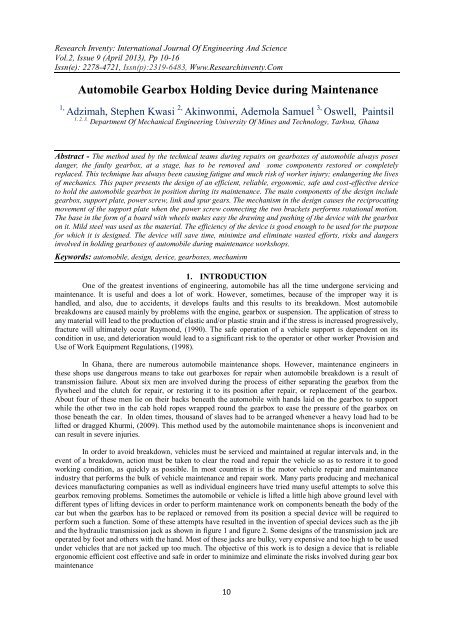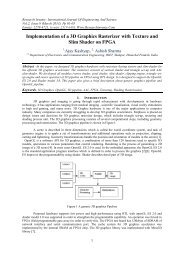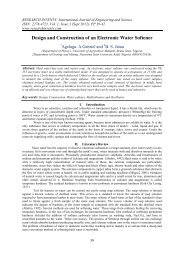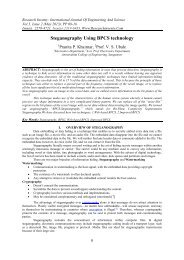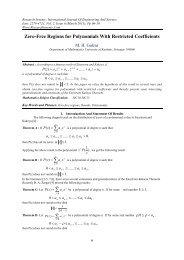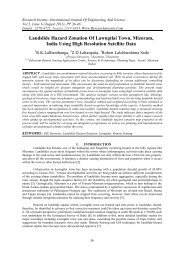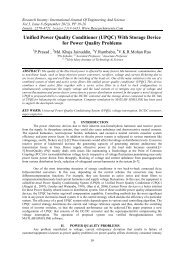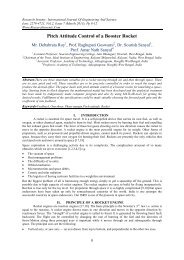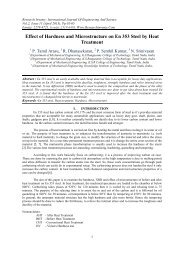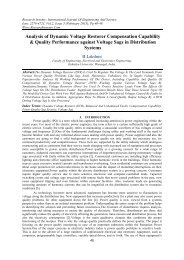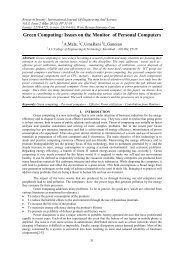Automobile Gearbox Holding Device during ... - Research Inventy
Automobile Gearbox Holding Device during ... - Research Inventy
Automobile Gearbox Holding Device during ... - Research Inventy
Create successful ePaper yourself
Turn your PDF publications into a flip-book with our unique Google optimized e-Paper software.
<strong>Research</strong> <strong>Inventy</strong>: International Journal Of Engineering And ScienceVol.2, Issue 9 (April 2013), Pp 10-16Issn(e): 2278-4721, Issn(p):2319-6483, Www.<strong>Research</strong>inventy.Com<strong>Automobile</strong> <strong>Gearbox</strong> <strong>Holding</strong> <strong>Device</strong> <strong>during</strong> Maintenance1,Adzimah, Stephen Kwasi 2, Akinwonmi, Ademola Samuel 3, Oswell, Paintsil1, 2, 3, Department Of Mechanical Engineering University Of Mines and Technology, Tarkwa, GhanaAbstract - The method used by the technical teams <strong>during</strong> repairs on gearboxes of automobile always posesdanger, the faulty gearbox, at a stage, has to be removed and some components restored or completelyreplaced. This technique has always been causing fatigue and much risk of worker injury; endangering the livesof mechanics. This paper presents the design of an efficient, reliable, ergonomic, safe and cost-effective deviceto hold the automobile gearbox in position <strong>during</strong> its maintenance. The main components of the design includegearbox, support plate, power screw, link and spur gears. The mechanism in the design causes the reciprocatingmovement of the support plate when the power screw connecting the two brackets performs rotational motion.The base in the form of a board with wheels makes easy the drawing and pushing of the device with the gearboxon it. Mild steel was used as the material. The efficiency of the device is good enough to be used for the purposefor which it is designed. The device will save time, minimize and eliminate wasted efforts, risks and dangersinvolved in holding gearboxes of automobile <strong>during</strong> maintenance workshops.Keywords: automobile, design, device, gearboxes, mechanism1. INTRODUCTIONOne of the greatest inventions of engineering, automobile has all the time undergone servicing andmaintenance. It is useful and does a lot of work. However, sometimes, because of the improper way it ishandled, and also, due to accidents, it develops faults and this results to its breakdown. Most automobilebreakdowns are caused mainly by problems with the engine, gearbox or suspension. The application of stress toany material will lead to the production of elastic and/or plastic strain and if the stress is increased progressively,fracture will ultimately occur Raymond, (1990). The safe operation of a vehicle support is dependent on itscondition in use, and deterioration would lead to a significant risk to the operator or other worker Provision andUse of Work Equipment Regulations, (1998).In Ghana, there are numerous automobile maintenance shops. However, maintenance engineers inthese shops use dangerous means to take out gearboxes for repair when automobile breakdown is a result oftransmission failure. About six men are involved <strong>during</strong> the process of either separating the gearbox from theflywheel and the clutch for repair, or restoring it to its position after repair, or replacement of the gearbox.About four of these men lie on their backs beneath the automobile with hands laid on the gearbox to supportwhile the other two in the cab hold ropes wrapped round the gearbox to ease the pressure of the gearbox onthose beneath the car. In olden times, thousand of slaves had to be arranged whenever a heavy load had to belifted or dragged Khurmi, (2009). This method used by the automobile maintenance shops is inconvenient andcan result in severe injuries.In order to avoid breakdown, vehicles must be serviced and maintained at regular intervals and, in theevent of a breakdown, action must be taken to clear the road and repair the vehicle so as to restore it to goodworking condition, as quickly as possible. In most countries it is the motor vehicle repair and maintenanceindustry that performs the bulk of vehicle maintenance and repair work. Many parts producing and mechanicaldevices manufacturing companies as well as individual engineers have tried many useful attempts to solve thisgearbox removing problems. Sometimes the automobile or vehicle is lifted a little high above ground level withdifferent types of lifting devices in order to perform maintenance work on components beneath the body of thecar but when the gearbox has to be replaced or removed from its position a special device will be required toperform such a function. Some of these attempts have resulted in the invention of special devices such as the jiband the hydraulic transmission jack as shown in figure 1 and figure 2. Some designs of the transmission jack areoperated by foot and others with the hand. Most of these jacks are bulky, very expensive and too high to be usedunder vehicles that are not jacked up too much. The objective of this work is to design a device that is reliableergonomic efficient cost effective and safe in order to minimize and eliminate the risks involved <strong>during</strong> gear boxmaintenance10
<strong>Automobile</strong> <strong>Gearbox</strong> <strong>Holding</strong> <strong>Device</strong>…(a)(b)Fig. 1 Jib Lifting <strong>Device</strong> in operationFig. 2 Hydraulic Transmission JackII. MATERIALS AND METHODS2.1 Description of the Proposed DesignThe proposed design is made up of several separate components put together to form a linkedmechanism. It has a support plate on which the gearbox will rest. There are also the links, joined together bypins to the brackets and the joints as shown in figure 3 and figure 4. This mechanism makes the up and downmovement of the support plate possible when the power screw connecting the two brackets is turned eitherclockwise or counterclockwise. The device also has a base in the form of a board with wheels to make easy thedrawing and pushing of the device with the gearbox on it. A motor is used to turn the power screw by means ofa gear.JointPower screwBracketFig. 3 Proposed Design11Link
<strong>Automobile</strong> <strong>Gearbox</strong> <strong>Holding</strong> <strong>Device</strong>…Fig.4 Front and End View of the Design2.2 Principle of Operation of the Proposed DesignThis design operates on the same principle on which a bolt and a nut operates in that when a boltrotates in a nut, it changes rotational angular motion to linear motion to transmit power or to develop largeforces. In this design, only one of the two brackets has its hole threaded. The other one has a smoothed hole. Theportion of the power screw that is through this hole is also smoothened to facilitate its rotational movement inthe hole. During operation, the operator presses the start button to start the motor which has a gear that is inmesh with another gear mounted on the power screw.2.3 Selection of the Materials for the Components of the Proposed DesignAISI 1025 steel with density 7.858 g/cm 3 , modulus of elasticity E 207 GPa, Poisson’s ratio 0.30, yieldstrength 370 MPa and a tensile strength of 440 MPa is selected for all the components Callister and Rethwisch,(2010) except the motor and the pins.2.4 Design Calculations of the Main ComponentsIn order to reduce material cost and component over design, a factor of safety 2 would be used for theproposed design. ( .The device is designed to support a maximum weight of 450 lbs. (2001.6 N.) When the jack is in the topposition the distance between the center lines of nuts is 400 mm and in the bottom this distance is 1000 mm. Theeight links of the device are symmetrical and 350 mm long each. The link pins in the base are set 400 mm apart.2.5 Design of <strong>Gearbox</strong> Support PlateThe support plate with the load distribution is shown in figure 5.W GRRWeight of gearbox, W G =2001.6 NReactions at the supports, RR2 RFig. 5 Support Plate with Load Distribution2 R4R = 2001.6 N12
<strong>Automobile</strong> <strong>Gearbox</strong> <strong>Holding</strong> <strong>Device</strong>…Assuming the <strong>Gearbox</strong> Support Plate to be a beam subjected to bending and shear stress, then applying themaximum shear stress theory;…………………………………… (1)Also; ………………………… (2)S. F (V) = 1000.8 – 5004(X) N…………………………………………… (3)B.M (M) = 1000.8(X)-5004Nm.andSubstituting these values into equations 2 and 3Cross sectional area, A = 0.55hand c =2.6 Design of Power ScrewThe Power Screw is shown in figure 6. A little consideration shows that the maximum load on thesquare threaded screw occurs when the jack is in the bottom position.Let θ be the angle of inclination of the link with the horizontal.From geometry, we find thatEach joint carries half the total load on the jack and due to this, the link is subjected to tension while the squarethreaded screw is under pull. The magnitude of the pull on the square threaded screw becomes;…………………………………………………………………….......(4)Since a similar pull acts on the other joint, therefore total tensile pull on the square threaded rod,Let core diameter of the screwWe know that load on the screw,=13
<strong>Automobile</strong> <strong>Gearbox</strong> <strong>Holding</strong> <strong>Device</strong>…Since the screw is also subjected to torsional shear stress, therefore to account for this, let us adoptUsing a pitch of 6 mm, normal or outer diameter of the screw,and mean diameter of the screw,Checking for principal stresses, ( is the helix angle)and the effort required to rotate the screw,Khurmi and Gupta, (2005)Using a coefficient of friction,Torque required rotating the screw,and shear stress in the screw due to torque,……………………….(6)Also, direct tensile stress in the screw,……………………………………………………………………….(7)Maximum principal (tensile) stress,………………………………………………..(8)Khurmi, (2005)and maximum shear stress,Since the maximum stresses are within safe limits, therefore the design of the square threaded screw issatisfactory.Fig. 6 Power Screw2.7 Design of LinkDue to the load, the links may buckle in two planes at right angles to each other. For buckling in thevertical plane (i.e. in the plane of the links), the links are considered as hinged at both ends and for buckling in aplane perpendicular to the vertical plane, it is considered as fixed at both ends Khurmi and Gupta, (2005).The maximum load on a linkThe links must be designed for a buckling load,………………………………………………………………….(9)Khurmi and Gupta,(2005)Letthickness of the link, andWidth of the link14
<strong>Automobile</strong> <strong>Gearbox</strong> <strong>Holding</strong> <strong>Device</strong>…Assuming the width of the link is two times the thickness of the link, i.e.of the link,, then the cross-sectional areaAndmoment of inertia of the cross-section of the link,Radius of gyration,………………………………………………(10)For buckling of the link in the vertical plane, the ends are considered as hinged Khurmi, (2005), thereforeequivalent length of the link,And Rankine’s constant,According to Rankine’s formula, buckling load ( ),Now considering the buckling of the link in a plane perpendicular to the vertical plane moment of inertia of thecross-section of the link,For buckling of the link in a plane perpendicular to the vertical plane, the ends are considered as fixed, thereforeEquivalent length of the link,Then,Substituting the value of, givesSince this buckling load is less than the calculated value (i.e.in the vertical plane.N), therefore the link is safe for bucklingFig. 7 Link2.8 Gear SpecificationThe gear on the power screw is preferred to rotate at a speed of 16 rpm ( . A module of 1.25 for thespur gears is needed (Budynas and Nisbett, 2008). The Spur gears should be cut at a pressure angle of 20 o and amotor of rated speed 60 rpmBecause the pitch diameter of the screw’s gear must exceed the normal diameter of the power screw, and alsonot too much than this value to reduce the torque on the gear, a pitch diameter of 51 mm is consideredappropriate for this design.15
<strong>Automobile</strong> <strong>Gearbox</strong> <strong>Holding</strong> <strong>Device</strong>…Then,Also,The pitch diameter of the motor’s gear,, therefore,2.9 Efficiency of the device, EFig. 8 Gear Mesh.......................................................................(11)WhereIII. DISCUSSION OF RESULTSA device which is efficient, reliable, ergonomic, safe and cost-effective device to hold the automobilegearbox in position <strong>during</strong> its maintenance has been designed. Figure 3 shows the proposed design while figure4 shows the front view and side view. The Principle of operation of the design is easy and user friendly. Therotation of the power screw causes the bracket with the hole threaded to move axially back and forth on thescrew enabling the links to oscillate and move the support plate up or down depending on the direction ofrotation of the screw. The major components of the design (<strong>Gearbox</strong> support plate, power screw, links andbase) are easy to fabricate and install.IV CONCLUSIONThis device will relieve stress and also prevent the possibilities of severe injuries on mechanics. Thedevice is efficient enough to be used for the purpose for which it was designed based on the efficiency.REFERENCES[1] Budynas, G. R. and Nisbett, K. J. (2011), Mechanical Engineering Design, McGraw-Hill Companies, Inc., New York, 9 th edition,1109 pp.[2] Callister, W. D. and Rethwisch, D. G. (2010), Materials Science And Engineering, an Introduction, John Wiley & Sons, Inc., 111River Street, Hoboken, 8 th edition, 88pp.[3] Karmot, (2011), <strong>Automobile</strong> Maintenance Accessories Handbook, 24 th ed., Karmot Inc., Peoria, USA, pp. 4–97.[4] Khurmi, R.S. (2009) A Textbook on Engineering Mechanics S. Chand and Company Ltd, Ram Nager, New Delhi 20 th RevisedEdition, pg171. ISBN 8121926165.[5] Khurmi, R.S. and Gupta, J.K. (2005), Machine Design, Eurasia Publishing House (PVT.) Ltd, Ram Nagar, New Delhi, 1230 pp.[6] Provision and Use of Work Equipment Regulations 1998. Safe use of work equipment.. Approved Code of Practice and guidanceL22 (Third edition) HSE Books ISBN 978 0 7176 6295 1[7] Raymond, A. Higgins (1990), Properties of Engineering Materials 4th Edition, Edward Arnold pp 348 ISBN 0340380349.16


